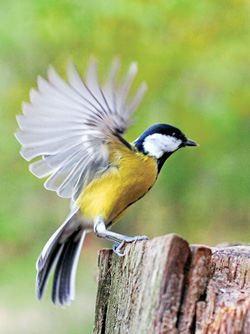Some 200 species of birds fly back to Ukraine every year

April 1 marks International Birds Day under the UNESCO program Man and Biosphere (the International Convention for the Protection of Birds was signed in 1906).
April marks not only the convention’s anniversary, but also the return of most birds. Ukraine boasts over 400 bird species, one half of which fly away to warmer lands every year. In some towns and villages people prepare for their homecoming by installing birdhouses or nest boxes. Last year this tradition was upheld by the cadets of the National Civil Defense University. They organized an entire birdhouse city in International Park. Regrettably, such projects are seldom carried out in big cities. In Kyiv, instead of attaching birdhouses to trees, trees are felled. Zhukiv and Trukhaniv islands on the Dnipro were the traditional places where birds settled every spring. Now the islands are built up and the birds have to look for other places to build their nests. More on this and other hazards facing our birds, the way they return home, in the following interview with Anatolii POLUDA, head of the Ukrainian Bird Ringing Center:
Have the routes annually followed by birds flying away from Ukraine for the winter changed over the past decades?
“These routes remain more or less the same. Take the white stork. Its migration routes have been studied for about a hundred years. These birds usually fly over western Ukraine, the Balkans, Turkey (the birds cross this country diagonally, in the direction of Syria), then on to the Middle East (Israel), Sinai Peninsula, and Africa where they settle for the winter. In recent years, however, some of the species have tended to spend the winter in Ukraine, specially in the south. I can’t say that the global warming is the reason, perhaps simply because there are additional food supplies. For example, there is an aeration station in Bortnychi (Kyiv) where warm water is discharged. Here you can see sandpipers and halcyons in winter. This year geese spent the winter near the Kyiv hydropower station, something they’d never done previously. The same is true of the white stork, for whom food is more important than the temperature. We also spotted quite a few ducks this winter. Again, an unprecedented occurrence. Hydropower plants keep discharging warm water that creates islands of clear water amidst the ice and birds can spend the winter there.”
What bird species are on the verge of extinction and why?
“There are specific reasons for every species. The Red Book lists over 80 bird species, including bustard that inhabits virgin steppe soils. It was practically doomed many years ago when [the Soviets] started destroying these virgin soils in Ukraine. The same is true of the steppe eagle that mostly feeds on gopher. When steppe soils started being cultivated this species vanished. The last pair of steppe eagles had a nest in Askania Nova 50 years ago. No more left in Ukraine. Water hen, for example, is very choosy about the nesting site. It needs marshland and only with sedge and stable water le-vel. This species is getting extinct because of land and bog reclamation, and pollution of rivers. Birds of prey suffered from a mass hunting campaign aimed at destroying them in the Soviet Union fifty years ago. They were believed to be the most dangerous rival of the Soviet equivalent of hunting business. New construction projects in the vicinity of birds’ nesting places are another negative factor. This problem is present in every big city, including Kyiv. When birds return to Trukhaniv or Zhukiv Island and see construction in progress, they fly away and will never build nests there, so sparrows and titmice are the only birds left.”






